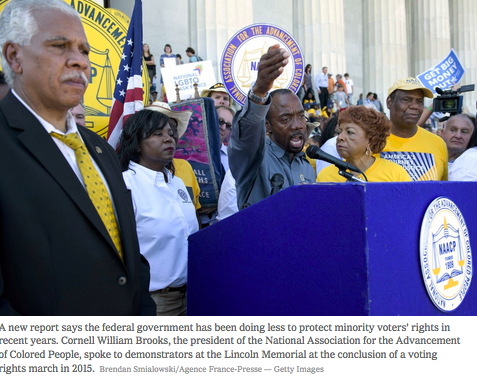Curator Note: This is a major statement regarding the Supreme Court’s 2010 Shelby decision, which effectively removed federal supervision from voting rights and allowed individual states to implement racially-motivated, voter discrimination laws and policies, per findings in the lower Courts. This is a direct result of a Supreme Court that does not see it’s role as supporting the voting rights of American citizens. It is also a major statement about how individual states undermine voting rights, when a Republican majority controls the statehouse.This is a dangerous precedent and harmful to our democracy. When the Congress changes hands, legislation re-establishing voting rights should be of the highest priority.
WASHINGTON — Federal actions to enforce voting rights for minorities have declined sharply since the Supreme Court struck down the core of the 1965 Voting Rights Act five years ago, the federal Commission on Civil Rights says in a sweeping new report on voting issues. Even enforcement of the act’s remaining provisions has dropped markedly, the report states.
In an interview before the report’s formal release on Wednesday, the head of the commission, Catherine E. Lhamon, called the present state of discrimination against minority voters “enduring and pernicious,” and said it was poorly addressed under federal law.
“To be at this point in our history, without either meaningful federal protections in law or in practice from the United States Department of Justice, is a low point” since the passage of the Voting Rights Act, she said. “And that’s dangerous.”
The United States Commission on Civil Rights, created during the Eisenhower administration in the wake of Brown v. Board of Education and the Montgomery bus boycott, is a bipartisan panel responsible for assessing the extent of discrimination and proposing ways to reduce it. The commission’s findings played a crucial role in the passage of major civil rights legislation in the 1960s and the Americans with Disabilities Act in 1990.
Minority_Voting_Access_2018 UNITED STATES — COMMISSION ON CIVIL RIGHTS
Findings
The right to vote is the bedrock of American democracy. It is, however, a right that has proven fragile and in need of both Constitutional and robust statutory protections. Racial discrimination in voting has proven to be a particularly pernicious and enduring American problem. Voter access issues, discrimination, and barriers to equal access for voters with disabilities and for voters with limited-English proficiency continue today. The VRA works to dislodge and deter the construction of barriers by state and local jurisdictions that block or abridge the right to vote of minority citizens. Preclearance proved a strong deterrent against state and local officials seeking to suppress the electoral power of growing minority communities through the enactment of policies and procedures that violated the protections of the VRA. In Shelby County, the Supreme Court acknowledged ongoing voting discrimination, and noted that Congress may draft new coverage criteria for preclearance based on current conditions that do not treat states unequally based on past conditions of discrimination. Without Section 5 preclearance, the DOJ has not been able to object to and prevent implementation of laws that courts later determined to have been specifically intended to limit black and Latino Americans’ right to vote. The Shelby County decision had the practical effect of signaling a loss of federal supervision in voting rights enforcement to states and local jurisdictions.
The voting laws implemented in North Carolina and Texas immediately following the Shelby County decision are examples of the direct impact of the decision on the behavior of state and local officials. In both states, after prolonged litigation, the changes were eventually found to be discriminatory. A review of these voting changes and the litigation challenging them show:
• Changes that were previously not precleared by the federal government under Section 5 in covered states were immediately implemented;
• Federal courts held that the laws were motivated by an intent to discriminate against minority voters, in one case, “with surgical precision;”
These voting changes remained in place through several elections, though courts eventually found that the changes were motivated by racial discrimination and/or had discriminatory effects; and
• Statewide discriminatory voting changes adversely impacted the rights of large numbers of eligible voters, and future judicial preclearance or “bail in” was not ordered by the courts in the wake of findings of intentionally racially discriminatory election changes. In the face of ongoing discrimination in voting procedures enacted by states across the country, enforcement and litigation under Section 2 of the VRA is an inadequate,costly, and often slow method for protecting voting rights.




